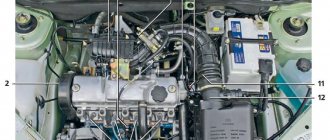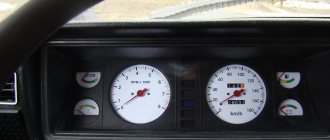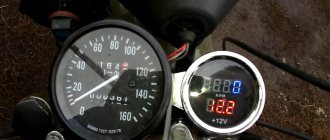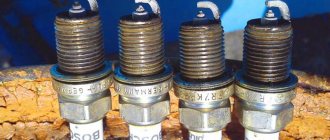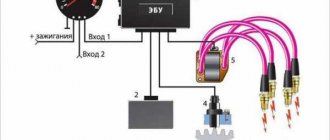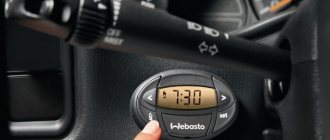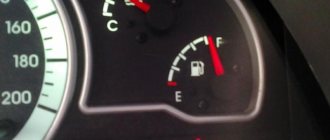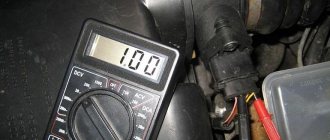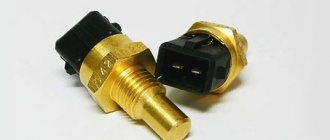01/26/2022 10 218 Dashboard
Author: Ivan Baranov
The tachometer informs the driver about the engine speed, allowing you to select the most profitable operating mode for the engine. If the tachometer needle jumps, the driver does not receive reliable information. The structure of the tachometer, its types, typical malfunctions and methods for eliminating them are described in this article.
[Hide]
Types of tachometers
There are two types of tachometers: analog and digital.
Analog instruments use an induction magnetic coil, thanks to which the number of crankshaft revolutions is shown by an arrow moving along the scale. This device is installed as standard on most machines. It is almost the same size as the speedometer and is located next to it on the dashboard. This arrangement of the device is convenient for the driver, since it is always in front of the eyes and makes it possible not to be distracted from the situation on the road.
In digital devices, information is reflected on a liquid crystal or diode display. The number of revolutions is transmitted either by a magnetic sensor that records the passage of a specific point on the crankshaft near the measuring device. An electronic sensor – optocoupler – can be installed. It generates a beam of light and determines the rotation frequency by its reflection from nearby objects. The digital device is useful when tuning engines and operations with electronic ignition units.
Photo gallery
1. Analog meter
2. Digital measuring device
Devices differ in their installation location. They can be regular or remote. The default mode is usually set to analog. If there is no standard device, you can install an external one yourself. It is often installed on racing cars to provide more accurate RPM readings, as speeds must be changed at a certain number of shaft revolutions. To achieve this goal, they are equipped with indicators that indicate when a certain speed is reached.
Information on pointer devices is better perceived by humans than on digital ones.
True, if the tachometer needle twitches, then the information may be unreliable. The advantage of digital analogues is accuracy, although under normal conditions this is not of great importance.
Why do the instrument panel arrows swing back and forth when starting the engine?
I think many people have noticed that when you turn on the ignition, the arrows on the speedometer and tachometer shudder, rising to the maximum value and returning back. This phenomenon occurs on most famous cars. At first glance, this is just a side effect that does not have any significance, but in practice it is allowed for a specific purpose.
On modern models, this function can be disabled, but to do this you will have to contact a dealership or service station that specializes in diagnosing and restoring on-board equipment. Interestingly, this is far from the only feature that manufacturers hide in the car’s control unit. Most car enthusiasts simply have no idea about the available functions, because basic knowledge is enough to drive their car.
Practical purpose
There is an opinion that the movement of the arrows when starting the engine serves only for an aesthetic effect
It does look nice and attract attention, but nothing in a good car just works. When the ignition is started, the arrows go through a full circle, which allows you to understand whether the device is working properly and whether the displayed indicators are correct
If the arrow moves smoothly, easily covering the distance from 0 to maximum and back, then the indicator is capable of working across the entire range. If you detect a deviation from the normal operation of the speedometer and tachometer, you should contact a service station or service center of your manufacturer. The reason for this may be a malfunction of the instrument panel element itself, or the problem is hidden in the engine itself and other on-board systems.
In this unobtrusive way, manufacturers offer their customers the opportunity to monitor the accurate display of indicators on the instrument panel.
For lovers of new products and innovations, I have a great offer!
The latest Linza DVR with a voice assistant and other various useful features will help you always be in trend and with the latest car gadgets.
And it's quite inexpensive. You can read more about all the functions and features of this DVR and buy it on their website by simply clicking here :)
Source
Device
The tachometer makes it possible to switch to another speed in time so that the engine operates in economical mode. A novice driver can focus on the position of the arrow. If it approaches the red zone, then you need to shift to a higher gear. In addition, the device is used to adjust the operation of the power unit at idle and control the crankshaft speed while driving (author of the video - Avto-Blogger.ru).
Analog tachometers are reliable and simple measuring instruments.
Their design includes the following elements:
- pointer arrow;
- graduated scale;
- an electromagnetic coil with a shielded winding;
- cable for transmitting information from the crankshaft.
The operation of the device is based on the electronic principle. The signal from the crankshaft is transmitted through wires to a microcircuit, thanks to which the needle moves along the dial. Information can be taken directly from the shaft, from the generator or from other power take-off shafts. In this case, the original signal is converted with a certain coefficient.
Why does the car jerk at idle?
Idle speed is one of the engine operating modes. It happens that at idle the car begins to twitch, that is, the engine runs unevenly.
This can be either a sharp or smooth change in the crankshaft speed, sometimes accompanied by vibrations. The reasons for this behavior of the machine can be completely different.
These may be malfunctions of both the engine itself and its ignition, power and control systems.
Engine
The cause of unstable idle may be a complete or partial failure of one of the cylinders. Most often, this engine behavior is associated with malfunctions of the gas distribution mechanism.
Ignition system
A car can jerk at idle due to malfunctions in the ignition system for several reasons, but all of them are associated either with a partial loss of the spark, or with an unpredictable change in the angle of its supply.
The absence or insufficient spark power is often caused by a malfunction of high-voltage devices, such as spark plugs, high-voltage wires, and ignition coils.
In addition, the spark parameters depend on the health of the switch or ignition module. The moment the spark is supplied is determined by the controller or distributor based on many parameters, the main ones being: the position and speed of rotation of the crankshaft, engine load, coolant and ambient air temperature.
Fuel system
A mixture that is too lean or too rich can also cause your car to jerk when idling. A lean mixture burns unevenly due to too much distance between the fuel molecules. Therefore, the crankshaft can rotate faster or slower.
The reasons for a lean mixture, in addition to improper operation of the carburetor or injector, can be any unintentional penetration of additional air into the intake manifold. For example, depressurization of the hose going to the vacuum brake booster.
A mixture that is too rich does not burn completely. As a result, a black, conductive carbon deposit forms on the spark plugs.
In this case, sparking partially disappears, which also leads to unstable engine operation.
The reasons for the enrichment of the mixture can be caused either by incorrect adjustment of the quality of the carburetor mixture, or by the presence of a malfunction in the fuel system or engine management system.
Possible malfunctions and ways to eliminate them
A jumping meter needle indicates a problem with the car. Repair depends on the cause of the problem.
You can list a number of reasons for device malfunction and ways to eliminate them:
- If there are poor contacts or damaged wiring, the source of signals from the motor to the device is lost. To detect a wiring fault, you need to check the electrical wires. If damage or breaks are found, the wires must be replaced. Poor contacts are often the result of oxidative processes. To restore functionality, the contacts need to be cleaned.
- Malnutrition. You should check the voltage on the positive and negative wires, as well as ground.
- If the tachometer needle floats or does not drop to zero, the reason may be a faulty sensor. In this case, it must be replaced.
- In the case of a digital device, it may not work if the LED screen is faulty. Such damage is possible with prolonged use. The display cannot be repaired; it can only be replaced with a working device.
- If the tachometer needle jumps at idle, there may be problems with the distributor. It is necessary to check the status of its contacts. In addition, the cause may be the distributor capacitor located on the cover. It is often punctured during operation.
- If the tachometer needle jumps, then the reason may be a violation of the integrity of the ignition system circuit. It needs to be checked and the fault corrected.
- The needle may move erratically after replacing the device. In this case, you need to configure it: adjust the position of the device itself, bring the pointer to zero, check the correct installation and connection. Adjustment is carried out using a toggle switch located on the rear panel of the device.
- If the needle jumps at high speeds, then the reason is the failure of the switch, which needs to be replaced. Problems with the engine are also possible, but these problems can only be detected by a specialist using special equipment.
- The cause of the malfunction may be the replacement of high-voltage wires of the ignition system, their wear or damage.
- The pointer may drop to the lower limit or twitch as the shape of the pulse on the coil changes. The reason is that the cross-section of standard cables has a different resistance. To resolve this problem, you need to reduce the value of the external resistor located on the tachometer microboard.
What's the result?
If the driver notices malfunctions in the tachometer, it is important to immediately determine the cause of the malfunction. It should be borne in mind that problems with the device itself are not critical for the car.
However, if the tachometer jumps due to problems with the engine, this symptom indicates the need for diagnostics. Ignoring this recommendation and further operating the vehicle may cause serious internal combustion engine malfunctions.
We also recommend reading the article about why the speed sensor in the car does not work. From this article you will learn why the speed sensor does not work, as well as how to check the specified sensor.
For example, breakdowns that can be caused by misfires and other failures can quickly destroy the engine. For this reason, it is important to monitor the tachometer while operating the car. If it is noticeable that the engine speed is floating or jumping, it is necessary to accurately determine and properly eliminate the malfunction.
How to remove the instrument panel
This will allow you to avoid short-circuiting the on-board network. Now you need to pull out the instrument panel. Remove the trim, and then carefully unscrew the steering wheel. After this, you need to remove the switches that are located under the steering control. Having done the above, you need to unscrew all the self-tapping bolts that hold the instrument panel in place.
Having completed all the above steps, you can remove the dashboard on which the instrument panel is mounted. To do this, you need to grab it by the edges and then pull it slightly in your direction. Now disconnect all the wires attached to the dashboard. But before you disconnect them, label each wire. This is necessary in order to avoid mistakes when putting the entire structure back together. After disconnecting the wires, pull out the dashboard.
Replacing the speed sensor
If the speedometer needle of a VAZ-2107 twitches, then it is necessary to replace the cable or worn-out gears, the edges of which have already worn out during the operation of the car. This rule applies to practically all cars that are equipped with a manual transmission. A speed sensor is installed in the automatic transmission. Let's look at the replacement process using Accent as an example.
To carry out the work, we will need to buy original speed sensors costing 800-900 rubles apiece. From the tool you need a wrench for 10 and 12, as well as the corresponding heads. There are two sensors in total. The first is located on top of the box, the second on the bottom. To get to the top one, you need to dismantle the air filter box and remove the battery from the platform. After that, use a 10mm key to unscrew the old one and install the new one. The lower sensor is located behind the left wheel. To get to it, you need to remove the box protection and the front part of the fender liner.
Description of the problem
Here's how it happens:
- The key turns in the lock, which means the ignition is turned on;
- The arrows rise sharply or smoothly and then return to their place, but not immediately.
Interestingly, the arrows move differently when the ignition is turned on. For example, on the tachometer and speedometer to half, and on the fuel scale and temperature scale - to the end.
The problem in this situation is considered only when the arrows do not fall back for a long time or do not do so at all. If they rise and fall into place after turning on the ignition, this is called self-diagnosis of the car. Many drivers even specifically want to have such a scheme (it is not found on all cars - mainly on sports cars, motorcycles and scooters).
When the ignition is turned off, the arrows rise
As for the problem, this is a “glitch” of the tidy, when the arrows do not fall back when the ignition is turned off. As a rule, the car owner in this case decides to remove the instrument panel. Inside, he tests the state of the elements, twirls the panel itself and the arrows, trying to find the cause of the problem. Some wash sensors and other components that are covered in dust, first removing the terminals from the battery, suspecting them of a “glitch” of the arrows. However, nothing helps.
Article on the topic: The principle of operation and design of the constant velocity joint (CV joint)
Classification by operating principle
- Mechanical or electromechanical tachometers with direct drive. The revolutions are transmitted to the dial indicator through a flexible shaft, which, through a worm gear, receives rotation directly from the crankshaft or one of the transmission shafts. The operating principle of the indicator is based on the phenomenon of eddy current induction. The operation and design of a magnetic tachometer are extremely similar to the operating principle of a car speedometer. In modern cars, a similar tachometer design is not used.
- Electric machine. A distinctive feature is the connection to a generator. It is used primarily on diesel engines, but for the purpose of unification, a device of this type can also be used on gasoline engines.
- Electronic. The signal can be taken either from the ignition system or directly from the computer. Installed on gasoline and diesel internal combustion engines.
Design and principle of operation
Main components of electric machine and electronic tachometers:
- measuring unit, or signal converter. It can be based on elements of analog circuitry or built using special microcircuits;
- display unit with analogue or digital display of the number of revolutions;
- auxiliary elements.
The operation of electronic tachometers is based on the conversion of individual signals or pulses captured from the computer, ignition system or generator into a signal “understandable” for the display unit.
Connection diagram
When looking for the reason why the tachometer does not work, it is first of all important to understand the connection diagram and the type of signal. There are 3 typical connection schemes:
- to a contactless ignition system (the tachometer wire is connected to the primary circuit of the ignition coil). The operating principle is based on measuring the frequency of voltage surges in the primary circuit of the ignition system. Calculating the ignition angle is impossible without focusing on the number of crankshaft revolutions, therefore the sparking frequency directly depends on the crankshaft rotation speed. On 4-cylinder internal combustion engines, a full revolution of the crankshaft corresponds to 2 voltage pulses in the primary circuit. Accordingly, the higher the crankshaft rotation speed, the greater the frequency of voltage surges;
- connection to the contact ignition system. The operating principle and connection diagram are similar to the BSZ, but the design of the measuring unit will differ depending on the voltage of the input circuit;
- connection to the engine ECU. The principle of operation is still based on recording voltage pulses in the primary circuit of the ignition system, but the signal to the tachometer comes from the engine control unit;
- connection to the generator (the tachometer signal contact is connected to terminal W of the generator). The rotation of the generator pulley is carried out by a belt drive from the crankshaft, so the rotation speed of the generator rotor will always be proportional to the crankshaft speed. The change in the number of revolutions of the crankshaft can be calculated by constantly measuring the amount of EMF generated on the winding. According to its principle of operation, an electric machine tachometer resembles a regular one class=”aligncenter” width=”448″ height=”412″[/img]
Typical faults
If the mechanical tachometer on a car stops working, there is mechanical damage to any of the structural elements. A broken cable of a flexible shaft, wear of the worm gear elements, the appearance of backlashes, deformations - all these reasons can cause the engine speed indicator to fail.
What to pay attention to if the electronic tachometer does not work:
- integrity of electrical wiring. In this case, it is important to check not only the signal wire, but also the ground and power supply of the instrument panel;
- quality of contacts. The presence of oxides and loose contact inside the chips may well cause the tachometer to fail;
- the integrity of the elements of the measuring unit, which are located behind the protective glass inside the dashboard. Among mechanical damage to transistors, burnout of microcircuits, tracks or swelling of resistors, the most common reason for a non-working tachometer is a violation of solder integrity. For example, on the Mitsubishi Padjero II, the appearance of microcracks in the soldering areas of the tachometer elements is a generally recognized disease.
On vehicles with an alternator connection, a non-functioning tachometer may indicate a faulty alternator. In this case, the breakdown is accompanied by the lighting of the low battery charge indicator and the sporadic lighting of a “garland” of warning lights on the dashboard.
In some types of design, changes in the linear resistance of high-voltage wires can make adjustments to the accuracy of the engine speed indication.
How to find the cause of the problem yourself
In addition to a visual inspection, for DIY diagnostics you will need a universal measuring device. If you know how to use a multimeter, you can easily check the power supply, ground, and also test the signal wire for a break.
The power supply is checked in DC measurement mode, the measurement range is up to 20 V. “Minus” is constant, “plus” appears only after the ignition is turned on. Pulses on the signal wire should appear when the crankshaft rotates. To search for a break, the multimeter must be switched to resistance measurement mode - ohmmeter. Sometimes, to detect a bad contact, it is enough to move the connector or harness in which the signal wire of the speed indicator is laid.
Tachometer needle twitches
The problem of a twitching needle is best known to owners of the GAZ 3110 Volga. The problem occurs on cars manufactured before September 1999 and equipped with instrument cluster 38.3801 (JSC Avtopribor). Due to design defects, the natural operation of a car generator, in which the amount of charging current is regulated by an alternating voltage supply to the excitation winding, leads to the twitching of the needle.
The tachometer needle may twitch due to weakened tension of the alternator belt, but in most cases it is possible to repair the tachometer on the Volga by replacing the dashboard and modifying the connection diagram.

